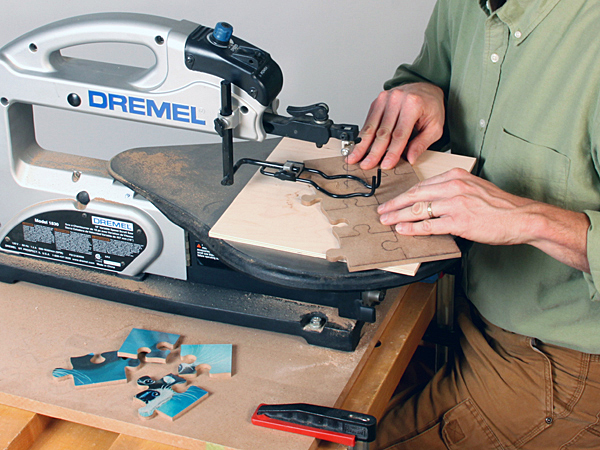
I’d like to make wooden puzzles from the pictures my granddaughter colors for me. We are coloring turtle puzzle pictures. Then I want to paste them onto, say, Masonite, then coat with lacquer or poly, then cut them out, then glue together to a backing. Questions I have for the editor are: what kind of glue to use? Do you use lacquer or poly? And what kind of wood? – Tom Maxim
Chris Marshall: Puzzles are a great way to make the most of this special artwork from your granddaughter!
Here are a few puzzle-making suggestions for you. First, I would mount the paper pictures to either ¼” MDF, Baltic birch plywood or Masonite. Any of these three will make durable backers for the puzzle pieces and cut pretty cleanly. You could either roll on a coat of white or yellow glue (I’d use a 4” foam paint roller), or spray the backer board with spray mount adhesive. Carefully lay the picture down on the glued backer, and flatten it gently with a towel wrapped around a piece of scrap wood to smooth out wrinkles or air pockets. Liquid glue will be more forgiving than spray mount glue for this flattening process. So, if you are inexperienced with spray mount glue, use white or yellow glue instead. Let the glue dry thoroughly.
If the pictures you’ve colored are in wax crayon, I would suggest topcoating the paper with Zinsser’s SealCoat—it’s a dewaxed shellac that will seal in the wax and allow you to topcoat the puzzle pieces with whatever you like (polyurethane or spray lacquer are both good choices). On the other hand, if you colored the pictures with dye-based markers, I’d start with an aerosol polyurethane instead of the SealCoat. Premixed shellac contains denatured alcohol, which could re-suspend the dye and smear the marker. I’d spray the backs of the puzzle pieces too, to make them more resistant to spills or wet fingers. Once the finish dries, cut out the puzzle pieces with a fine-tooth blade in a benchtop scroll saw (I don’t mean a jigsaw here, but an actual scroll saw). You want the cleanest, tightest-fitting cuts you can get, and a scroll saw is the best tool for that job. Smooth the cut edges with 180-grit sandpaper, and your puzzles are finished.
Enjoy the puzzle-making process, and your time together!
Tim Inman: I think Chris has this one answered for you. I’m going to add a suggestion I have used with my kids, though. Instead of finishing your pictures with a conventional wood finish, have them dry-mount laminated in plastic. Just about any shop that deals in paper or copying can do this for you. Most school art departments have the gear to do it, too. The picture will be permanently sandwiched between a very durable film top and bottom. Then, glue the laminated picture to Masonite, etc. with a spray/aerosol contact adhesive like 3M #77 or #90. Presto! Permanent, washable, lifetime durable puzzles.





